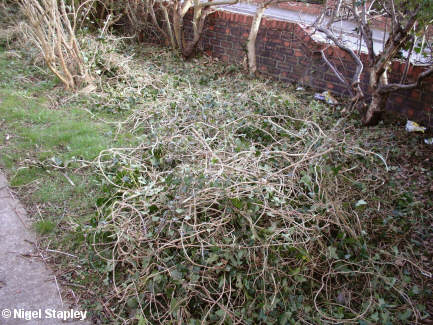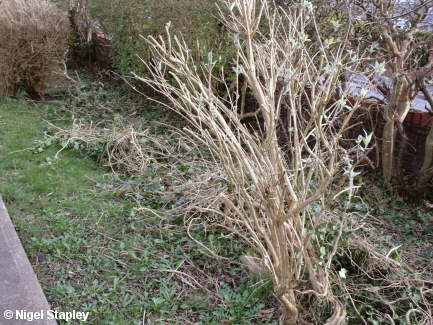 This Is Not A
BLOG!
This Is Not A
BLOG!
Date: 01/04/21
Hedera Sucks, Y'all
The hounds of Spring are on Winter's traces, although we've had snow forecast for next Monday, so the snow will likely be yellow as a result.
In any case, the garden is now demanding attention like a spoiled three-year-old, so the house is going to have to swivel on it for a bit. To be fair, what with one thing and another I haven't given the garden the care it warrants over the last few years, and I no longer have much of an excuse for any continuing neglect.
I had already gone around in November and early December doing some ninja topiary on all the bushes which had got out of hand - two red-flowering currants, an elder (absolutely mings when you cut it, does that), two forsythia, two cotoneaster, a philadelphus, a spiraea, a buddleia and the globosa which forms part of the hedge. This left me with a big pile of detritus at precisely the point in the year when the Council reduces its garden waste collection (for which they now charge an extra £25 per year on top of the Council Tax) from fortnightly to monthly, so that had to be stacked against the back garden wall to await disposal on the installment plan.
I recounted last July my attempts to rid the side-lawn (if 'lawn' is the word for it; it'd be a bit like calling a severe case of male-pattern baldness a mullet) of ivy, but I decided to leave what was growing in the hedge well alone. After all, I reasoned, it was filling some space up and providing thereby a bit more of a screen from the pavement up the side of the house (as you can see on the left-hand side of the last photograph on this Gallery page).
A couple of weeks ago though, I got the feeling that it really had got more than somewhat out of hand. It had started growing up the main trunk of the silver birch tree at the corner of the back garden (see that same photograph) for a start, and there were indications that it was doing rather more than just filling gaps and was instead mounting a takeover for the whole hedge. So a week last Sunday morning, I decided to have at it.
I quickly realised that I wasn't going to be able to do much in re the birch because I couldn't get close enough to reach up and pull the ivy down without a ladder of some description. The land up there is too uneven to take a ladder anyway, even were I not crap with ladders in the first place. So - having contented myself with just cutting the stems where I could reach them, hoping that it would kill at least some of it - I turned my attention to the hedge beneath.
I've mentioned before that my hedge is a Heinzian thing comprising, if not fifty-seven, then a number of types of plant. At the back end, the varieties are privet, laurel, something which may be hornbeam but I'm still not sure, and hawthorn, and it was in and under these that I set to it.
The hedge at this point is pretty thick, inside to outside, and this meant a fair bit of crawling about to get hold of as much of the root of the problem as possible, as simply pulling it from where it would normally be reachable would just snap the stems and render the rest of the wretched stuff all but undiscoverable, it being a bit dark under there.
(What anyone walking past at this point would have made of the ominous - and apparently causeless - movement and sound coming from within, I can't imagine. I suppose I could have gently sung the seventh verse of Stairway To Heaven to reassure them; it would at least have covered up the worst of the swearing, which was decidedly less than musical).
After a couple of hours of this, I was left with a small collection of straggly herbiage which was dumped on top of the pile of dead bush cuttings against the wall adjoining next door.
There was then a stretch under the first bit of hawthorn and the globosa which had no substantial growth of ivy at all - just a bit trying to climb up the latter, which I removed with little effort. I then knocked off for the day.
Monday morning saw me back out there again to continue from by the second stretch of hawthorn onwards towards the front corner. This marked the point at which the ivy had started to weave its way through the hedge and wrap itself tightly around whatever it was climbing up. It could be seen entwined with the hawthorn and the adjoining large stretch of privet.
This, however, was no longer quite as large a stretch as it had been before. I don't care what Wikipedia and The Woodland Trust say about ivy not causing damage to any other plants; the chunks of dead trunk I was breaking off whilst pulling away at the stuff was testimony to the contrary, and showed that I had been right to try to get rid of as much of it as possible.
This marked the point where the job got seriously out of hand. For not only had the wretched hedera helix grown sideways along the inside and top of the wall, it had lived up to the second half of its nomenclature by climbing up through whatever type of hedge was present in throttlingly tight stems and emerging in its mature form - incipient berries and all - up into the light. Tugging at it was not, in and of itself, going to be enough to remove it, as the stems had adhered themselves limpet-fashion to the trunk and branches all the way up.
This meant serious weaponry had to be deployed, in the form of secateurs allied to brute force. Part of the problem was that I was now in the third area of hawthorn, and reaching through that to get to where I needed to wield the implement to cut or prise the stems off the wood would have led to my looking like a self-harmer were it not for the fact that it was quite chilly and I had a sweater on. Unfortunately, this meant that said garment kept getting caught on the thorns, always in such a way as to render disengagement from it annoyingly difficult.
When Day Three arrived, I reached the area where the ivy had taken advantage of a large gap in the hedge at wall level (see the first photograph below) to grow to a depth of about six inches and a height of about eight or nine inches above the top of the brickwork. It was as dense as a backbench MP in there, and pulling at one area was causing the ivy up to four or five feet further along the wall to move with not so much a rustle as a seismic wave. It was like a metaphor for the whole Universe, in that everything seemed to be irretrievably interconnected with everything else to such a degree that it would probably take the horticultural equivalent of Neil deGrasse Tyson to explain what was going on. Not only was it wrapped around the hedge, it was thoroughly entangled with itself, and this entailed my grabbing big fistfuls of the bastard thing and hauling on it like a crazed matelot during a tropical gale. I may have scared more than one passing pedestrian during this process (if the language hadn't scandalised them first, of course).
Clump after clump, skein after skein came away (sometimes with a malicious sudden-ness which caused me to tumble backwards onto my arse), yet after two hours or more there still seemed to be as much to evict as had been already evicted. The damage that the ivy had done could be assayed not only by the bits of dead hedge which were coming away with it, but the shards of brick which the plant had suckered itself on to and was refusing to relinquish.
With that native bloody-mindedness which has made me the wreck I am today, I persevered until the gap was cleared of all bar those growths which had too tightly annexed the next section along to be removed without further invasion plans, and I knocked off for the day.
Day Four (or, as it was called in the Old Calendar, Wednesday) saw me - with a degree of reluctance with which I hope My Reader can empathise - reach the large, dense area of privet on the corner. The ivy had grown strongly along the wall here in addition to burrowing up through the hedge, and this entailed a great deal of burrowing on my own part as I tried to get at the roots at the bottom and the thoroughly entangled developments further up. At least, it not being hawthorn, I didn't end up scratched to buggery with it, although my baseball cap (Minnesota Twins, road-game version, won on Channel Five's MLB coverage in the early 2000s, as modelled in the third photo down here) kept getting knocked off my head as I crawled further into the thicket.
As with Days Two and Three, it was necessary to go out onto the pavement to try to deal with it from that side instead, so integral a part of the whole had the ivy become. And, as with those earlier days, there were threads and clumps of leaves which I couldn't be arsed dealing with and left in place, hopefully to die horribly in short order.
I worked my way around the corner towards the gate with the same grim sedulousness I had demonstrated all along, and was within a couple of feet of the gatepost when I encountered an unmistakable stench. Yes, one of our neighbourhood moggies had left a little gift of lurve somewhere (I don't know - and most emphatically don't want to know - what they put in cat nosh, but when it comes out at the southern end, it deserves to be covered by an international interdict of some sort). As I had no way of being able to see where exactly the effluent was, I decided that I would go no further as the smell of the stuff lingers for days if you get it on you or your clothing. So, I downed tools and called it a job.
I then turned around to survey the result of my efforts. This was what I saw:


(As with the stuff you cut off the hedge itself, you always end up with far more volume than you would have had had you left it all in situ. It's a microcosm of the Expanding Universe).
All that was left was for me was to lug the remains round the back of the house, to be decanted into the garden waste bin after its now-fortnightly collection. At the current rate, I should have rid myself of it all by about mid-June.
I'm under no illusions about the long-term efficacy of what I've done, of course; I've had too much experience of domestic horticulture to be sure of anything other than the job needing to be done again ere too long. At least I can keep more control over it now and stop it from going critical again.


 This Is Not A
BLOG!
This Is Not A
BLOG!











